Tag: gameplay
Tilt: An Essay
In the second installment of her two-part essay, writer Virginia Heffernan continues her pinball pilgrimage and humanizes the digital-analog divide. Missed part 1? Read it here.
There were also beeps in this game. When my balls—my extra balls by now, I’m that good—hit one particular bumper and bounced back on it, again and again, piling up points and aiming me for the leaderboard, the beeps beeped furiously. Each one was a half-second, more or less tonal, and—as usual for me—beeps sit on the knife’s edge of puzzling and rapturous.
Beeps belong to nature and electricity and electronics and the Internet. All the centuries. Like the railroad toot but unlike an old telephone ring, beeps have both a distinct start and finish, marked by the twin plosives “b” and “p,” and an elastic center that can generously expand and contract like an accordion: beeeeeeeep. You can create Morse code in beeps. Beeeep beep beep beep. Beep. Beep. Beep beeeep beeeep beep. Yes, they’re a frankensound—but nature can almost, almost suggest them. They certainly seem to have always existed. Maybe art teases beeps out of nature.
The beep is synthetic; it’s manmade, like climate change. Plants don’t beep, nor weather, nor animals, nor birds except Road Runner. If you hear a beep, you know that a person, or more likely his artifact, is signaling. There’s no wondering, Is that a beep or a nightingale? Is that a beep or a tornado? Beeps are also not voices or music.
And still, sonically exotic as they may be, beeps are, as my pinball home insistently suggested, easy to make; they are cheap and light. No wonder everything beeps. E-mail beeps. Texts. Trucks in reverse. Hospital monitors. Stoves, dashboards, cameras, clocks. Coffee machines. Dishwashers. Elevators. Toys. Robots. Toy robots.
[In] the Monopoly game the beeps were modulated and engineered to define my experience, the very victories I thought I was creating with my analog tendons and fingertips and wrists.
The onomatopoeic word “beep” launched in 1929, and prewar beeps were produced by car horns, though sonar, electric elevators, and clown horns may have beeped or protobeeped even before the 1920s. Other car horns of the period, and now especially those of big cars, are usually heard to “honk.” Beeps as the sound of cute cars—makes sense. A small, zippy, nuisancey thing chirping, “’Scuse me, could you move a smidge? Thanks!” That’s a beep.
As a source for beeps, car horns gave way to piezoelectric technology, a breakthrough used increasingly after World War II in labs, hospitals, and military operations. With the arrival of the transistor, small piezo buzzers could be made to beep in devices like electronic metronomes and game-show buzzers. An efficient, low-power way to gin up a tone for a device to emit. Beeps could now be heard in a range of contexts, but the sound still managed to speak of seriousness and technology.
The material world and our bodies, in concert, can reconfigure themselves, as if to prove they can’t be digitized.
Were those beeps on the pinball playfield digitized? I choose to believe they were not made in sound labs, but date from the bells and horns of J.P. Morgan days. That every time a ball hit a bumper it squeaked because it was weighted metal on hard, smooth rubber, and something in the angle—and I misread it as a beep—but I’m not crazy: Naturally on the Monopoly game the beeps were modulated and engineered to define my experience, the very victories I thought I was creating with my analog tendons and fingertips and wrists.
Beautifully, submissively, we have adjusted to the hegemony of computers. But this Monopoly table, with its rusty screws and peeled paint, suggests one road back or through to an ecstatic, three-dimensional, and entirely mortal form of culture, in which our imperfect and limited bodies might reassert their centrality to culture, politics, and philosophy. This reassertion I anticipate with some giddiness the way, in my Bolshevik days, I used to anticipate the digital revolution. This time I resolve not to be so impatient with my elders.
The material world and our bodies, in concert, can yet reconfigure themselves, as if to prove they can’t be digitized. I believe that. In games like this one, from 2001, before broadband razed our nervous systems, I hear trills of promise. Of course, on this day, I was at forty-five in the middle of the journey my life, lost in the dark wood of an executive hotel. I was a truant; I had skipped a conference for a stolen pinball game. And reader: I was winning. ♦
(Image credit: Pinball by el-toro on Flickr.)
What’s your take on the MANIFESTO? Tell us: PLAY is ____________. #PEMplaytime
Ball Games and War Games: An Essay
Carlo Rotella examines the threads of play in his upbringing in an essay in three sections. Here, in the second installment, we resume his story on the basketball courts of Chicago, where Rotella learned to navigate the complex social world of pickup basketball. Check out part 1 here.
At the opposite end of the spectrum from the elaborate tactical board games over which I hunched for hours and days at a time as a child, learning the ins and outs of military strategy while perfecting the art of being alone, was pickup basketball: a laboratory for developing social self-knowledge and expertise. First, you had to get in the game. Say you showed up as part of a crew of four at a playground where a full-court five-on-five was in progress and there were seven guys already waiting. That meant there was a team of five ready to go next, with two left over. You’d have to figure out who those two were and size them up, then decide whether to a) sit out two more games until you and your whole crew could pick up one guy at courtside and constitute a team of five; or b) put forward three of your crew as teammates for the two current leftovers and thus get onto the court after sitting out only one game, though that would leave one of your number to fend for himself; or c) if those waiting seemed exceptionally weak or fractious or otherwise unequipped to defend their claim, brazenly declare that your crew had next and enlist the big dude in the cut-off Brothers Johnson T-shirt as your fifth. The negotiations could get tricky, with everyone assessing everyone else’s skill, size, confidence, willingness to back his own claim, and support from allies. If somebody tried to pull a fast one by claiming at the last moment, just as you and your crew were about to take the court to play your duly called next game, that he had actually called next way before but then had been obliged to go to take care of some business but had now come back, you had to decide whether to get all lawyerly in response or to simply brush aside this pretender, dismissing his claim out of hand as sorry-ass would-be gangster bullshit not even worth a reasoned rebuttal. However you played it, the main thing was to act as if you were the kind of guy who got in the game as a matter of course, and not the kind who could be pushed out of line with a strong-arm move.
I was obliged to cultivate the specific skill of playing with and especially against one’s betters, a skill not identical to being good at basketball.
Once in the game, I had to survive it. Because I hung out with serious players who tended to get me in with stiffer competition than my modest abilities rated, I was obliged to cultivate the specific skill of playing with and especially against one’s betters, a skill not identical to being good at basketball. My main challenge was to fend off humiliation when matched man-to-man against a member of the other team who, if we both did our best, could outscore me so badly that it would obviously be my fault if my team lost. That meant playing serious defense, which was not generally regarded as a principal virtue in pickup ball. I began by taking calipers to my man’s footwork, figuring out how much room he required to operate smoothly, then moved inside that limit, finding the sweet spot of his discomfort. I wanted to be just close enough that I was perpetually, irksomely there; rather than trying to prevent my man from doing what he wanted to do―get the ball, dribble, shoot―I just tried to make it unpleasant and difficult for him to do these things. By staying close and varying the rhythm of my intrusions to keep the irritation fresh, I could make him feel that there were extra feet where he wanted to step, extra bulk clogging up his movements. I used my hands on him as little as possible. I’d just follow, follow, follow, lining up my navel with his at the chosen distance and then trying to keep them lined up no matter what he did, so that he would begin to feel as if he was dragging around my body and will, my whole story, in addition to his own. I aspired to be like Jack Vance’s Chun the Unavoidable, who, even after the fleet and cruelly handsome Liane the Wayfarer slips into a sorcerous portable hole to escape him, shows up at Liane’s elbow in his coat of eyeballs and says, “I am Chun the Unavoidable.”
I appeared to be model citizen of the little commonwealth of the pickup team.
I appeared to be model citizen of the little commonwealth of the pickup team because I performed needful tasks that most other players, fixated on the universally acknowledged priority of racking up points, didn’t feel like doing. In addition to playing defense on my man with irksome persistence, I passed the ball to teammates with care and sensitivity, boxed out, rebounded, fetched loose balls, tipped away opponents’ passes, and ran the court on every possession. But this appearance of good citizenship was an illusion: other than wanting to win so that I could stay on the court, I was, at best, agnostic about the greater good of my teammates; at worst, I was willing to sacrifice them in the cause of preserving my own dignity. My basketball self, a bad person masquerading as a good neighbor, only incidentally made his teammates’ lives better by making opponents’ worse. Intent on holding my own by destroying my man’s virtuosity and dragging him down to my level, I regarded offense―the soul of the pickup game―as wildly overrated. Offense was mere slavishness posing as inspiration, a company man’s sorry campaign to make Employee of the Month. But defense―not the rah-rah kind but the I-live-you-die kind―was the essential business of denying your enemies their heart’s desire, which was to put your hamlet and crops to the torch and carry off your loved ones into the night.
Return to the first installment of “Ball Games and War Games.” Read part three here.
(Image credit: A pickup basketball game in Chicago’s Lake Meadow Park, 1970 (Lake Meadow Park (0263) Activities – Sports, 1970.). Courtesy of the Chicago Public Library.)
Performing the Real: An Essay
Live action role-playing—or larping—has garnered thousands of fans and soared in popularity over the last decade. Larp expert Lizzie Stark demystifies this deeply expressive form of storytelling.
I have many personas. Like most people, I select particular social masks for different occasions. Among my personas are those of business woman, granddaughter, and friend. All of these social roles are distinct, and they come with distinct modes of conversation and costuming. I make ribald jokes with my friends, but never my grandmother or editor; I watch movies in my pajamas with my grandmother and friends, but dress appropriately for that networking coffee. In other words, I calibrate my appearance and behavior—my persona—as best I can, according to the situation. Everyone does. I can channel any one of more than a dozen social masks—taskmistress, loving wife, or zany artist—during the day as needed.
The stories larp tells are quite diverse. You might play hobbits trying to save Middle-earth; members of a rural Oklahoma community locked in a bomb shelter after the Cuban Missile Crisis goes awry; or fairy tale creatures at a union board meeting. The only limits are the imaginations of the game designer and her player.
The essence of larp is experiential. Participants meet up in real time and space, guided by a facilitator and constrained by the world the designers have built, take on the role of a character, and play out their own character arcs. Sometimes the relationship between the game world and the real world is direct, and sometimes it is symbolic. You can assemble a beautiful costume and play a game about life in a wizarding college in a real life Polish castle, where everything you see is present in the game, as players did in the larp College of Wizardry. And you can live in that reality for days at a time. This is called a 360-degree aesthetic—it’s a larp played in an environment as close to the production’s real setting as the larp designers can reasonably get. Time moves at the same speed both in and out of game—a ten minute walk takes ten minutes in the real world as well as the larp universe; your character looks like and is wearing whatever you are wearing; the game setting is a castle and you are in an actual castle.
Plenty of larps eschew the window-dressing. Freeform and black box larps make use of space and time symbolically. Set in unadorned conference rooms and classrooms, these productions don’t require fancy props, set, or costuming. If power of imagination can transform you into the personification of “tethered love,” as in Peter Fallesen’s Let the World Burn, then what you’re wearing is probably irrelevant. A disposable coffee cup can easily stand in for a bouquet of flowers, an urn for grandmother’s ashes, the world’s last bowl of soup, or anything else that is physically needed. In this style of game, designers can telescope time in and out. We can play out the first flirtation between two characters, as in Emily Care Boss’ Under My Skin, cut to the next flirtation a week later, and play out the entire character arc of infidelity of several couples in a little under five hours. Or perhaps we play the same five-minute scene over and over again for two hours until we have discovered every iota of nuance present.
Larps vary widely—in the stories they tell, in the production values they require, the amount of time they last, and the tools they use to heighten and calibrate the story. Over the last five years, I have spent transformative hours as a young man at the height of the AIDS epidemic; helped allocate a family inheritance by breaking numerous china coffee cups; lived as a servant in Jane Austen’s world for four days; and transformed the flavor of garlic into a character, a second-generation immigrant desperately trying to hold family tradition together. I’ve been a refugee, a settler, a douchey mountain-climber, a manic pixie dream girl commando, a professional nail technician, the democratically elected dictator for life of a space colony, and a ghost suing for possession of the kitchen I haunt.
To think of larp as becoming a completely different person is both true, and a fundamental misunderstanding.
Playing these roles—many of them pre-written in short paragraphs—always requires acts of creation. Newcomers to larp often tell me they couldn’t become a completely different person for a few hours or days—it would just be too hard. But to think of larp as becoming a completely different person is both true, and a fundamental misunderstanding of what happens when a larper plays a character. I am not a gay man at the height of the AIDS epidemic. But the process of playing one in Tor Kjetil Edland’s I Say a Little Prayer forced me to map the character of Benny, the new single boy in town who often acts without thinking, to Lizzie, the overly analytic, straight, married journalist. To do so, I had to connect filaments of my own identity with parts of Benny’s. During a larp you’re continuously improvising, responding to situations and other characters on the fly. There simply isn’t enough time to construct a vision of the character that is completely separate from yourself. By necessity, you spin a character out of the stuff that makes up your own soul. Essentially, larp allows us to say, “I’m not Benny. But if I were Benny, my life might have gone like this.”
As in all art, my experience as Benny was made more meaningful through the designer’s use of structure and techniques. I Say a Little Prayer featured, among other things, a thematic act structure. Every act concluded with a lottery of death, designed to represent the randomness and terror of the early AIDS epidemic. Each surviving character put at least one ticket into those lotteries—more, if they had engaged in risky sexual behavior. During the act breaks, the facilitator drew a name out of the hat, a character died, and we held a funeral that represented our connection to the dead character with touch.
I still don’t know what it was like to be a young gay man at the height of the AIDS epidemic, but by playing one in this larp, I have a better understanding of what it might have been like. I had to recognize the shared humanity between Benny and myself. And in doing so, I also put on and connected with certain parts of my personality, for example, the part that is terrified by the early death of people I love. There’s my friend Cheri, dead of metastatic breast cancer at 35; my cousin Kitt, dead of a skiing accident at age 19; or the litany of female relatives whose genetic error I share, dead of breast and ovarian cancer quite young.
Larp manipulates the social masks we have inside of us for many purposes—catharsis, aesthetics, and even fun. Because larp allows players to tap into their fundamental personal essences, it allows participants to connect with each other very deeply in very short amounts of time.
As I said at the outset: larp manipulates the social masks we have inside of us for many purposes—catharsis, aesthetics, and even fun. I sometimes think of core personality as being a bit like a river of liquid rock—no one vessel can contain it completely, though it can be channeled into manageable eddies, and scientists can safely sample it in small quantities and purpose-made containers. In other words, as Walt Whitman put it in Song of Myself, “I am large, I contain multitudes.” Every human embodies multiple identities—we are mothers but also daughters and granddaughters, writers but also amateur chefs, jokers who can be deadly serious when the situation demands it. Together, these roles and how we approach them—each its own eddy of the lava flow—make up our core humanity and identity.
Because larp allows players to tap into and perform their fundamental personal essences, it allows participants to connect with each other very deeply in very short amounts of time. And it does this both by asking participants to play roles, and by asking them to improvise all their own lines. They are themselves, but different. Consider improv theater pioneer Keith Johnstone’s advice on the form (which is connected to but not identical with larp). Johnstone advises improvisers to “be obvious” because your obviousness is really your true self; it comes out of you and will therefore be different from my obviousness. If I ask you what you’d bring on our trip to Mars and your first impulse is to say, “a Kenny Loggins tape,” then you’ve revealed something about your true self. This stands in stark contrast to traditional social situations, where the lines we utter can be almost scripted—polite conversation consists of exchanging pleasantries—and those scripts remain remarkably similar across different social situations and individuals. Consider the narrow range of appropriate responses to the question “How you doing?”; “Fine. You?”; “Good.” The wild situations and setups of larp free us from these socially prescribed exchanges, and in doing so, open up possibilities for deep human connection.
In the second installment of Lizzie Stark’s essay on larping, she explains how the role-playing game provides alibi for an experience.
(Image credit: © College of Wizardry 2017)
Spycraft: An Essay
Journalist Charlie Hall offers a look into the art of making board games for the CIA. Acclaimed designer Volko Ruhnke shares a whole new meaning to the term “serious games” with him.
The United States intelligence community has a long history with gaming. Role-playing and simulations have been part of the Central Intelligence Agency’s best practices for generations, and are often conducted with the help of judges and mediators behind closed doors to explore complex, real-world situations.
But recently, the CIA revealed that they also use tabletop games—in effect, complex modern board games—to train its own analysts, and analysts from other agencies.
By day, Volko Ruhnke is an instructor at the CIA’s Sherman Kent School for Intelligence Analysis. By night, Ruhnke is an acclaimed designer of commercial board games best known for the COIN Series, published by GMT Games. He said the CIA has been interested in tabletop games for a very long time, well before he started working there in the 1980s. Applying his knowhow in the commercial space to building games for CIA officers in a classroom setting was a natural fit. The goal, he explained, is to facilitate repetition in the practical application of intelligence gathering skills, about separating actionable information from noise and acting on it quickly.
Unlike commercial board games, Ruhnke’s projects at the CIA don’t need to be fun.
Ruhnke shared an example of his work, a project called Kingpin: The Hunt for El Chapo, which he co-designed with another instructor in the Defense Intelligence Agency. Kingpin uses the historical details of the capture of Sinaloa drug cartel leader Joaquín “El Chapo” Guzmán as well as some fictional elements to create a challenging, asymmetrical game.
Kingpin is an adversarial game where one side plays the role of law enforcement and the other plays the role of Guzmán’s own handlers and associates. It revolves around hidden information, with each side playing on their own hidden game board behind a screen. El Chapo’s team is constantly moving around inside Mexico trying to evade the law, but the cartel leader has certain tastes and expectations. He’s not just willing to sit inside a hole somewhere, and one viable strategy is for law enforcement to use his proclivities against him. In the classroom, the game is played twice, with students taking turns playing on both sides of the table.
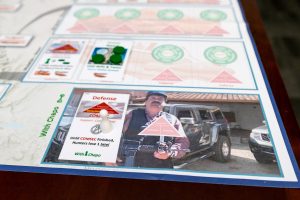
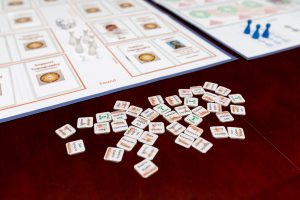
The key to the game, and to every other game played at the Kent School, is the facilitator. It’s their responsibility to keep things moving by interpreting the rules and feeding them to students on the fly. But in Kingpin, the facilitator also plays the role of referee. They have an important role in moving the action forward by revealing new information to both sides.
Unlike commercial board games, Ruhnke’s projects at the CIA don’t need to be fun. They also don’t need to support multiple playthroughs. In fact, they don’t even need to be played to completion.
“For a training game, it’s not nearly as important that you finish the game,” Ruhnke said. “It’s not even important that the game be balanced or have replay value. It might have those things. But our students are probably never going to play it again. It’s more about the insights and the process.”

Games are a very small fraction of what Kent School students will do in their coursework, but Ruhnke said the kind of hands-on work that tabletop gaming provides is invaluable.
Humans deal with complexity by forming mental models. . . . as instructors, we have to communicate those models to our students. Games do that very well.
“They are a tremendous tool for helping us prepare our understanding of complex affairs,” Ruhnke said. He likened it to studying the ongoing instability in Iraq and Afghanistan. “An insurgency is the interactions of many different actors, interests, tribes, forces, political movements, parties, village elders. It’s a complex compilation of factors, and that’s what we’re asking our analysts to understand. But human beings deal with complexity by forming mental models. So now, as instructors, we have to communicate those models to our students. Games do that very well.”
I was first introduced to the Ruhnke’s design work with a game called Labyrinth: The War on Terror, 2001 – ?, first published in 2010. In it, one player takes on the role of the United States while the other plays as Islamic jihadists. Each player takes actions by playing from a hand of cards that includes real-world, historical events. In one of my most memorable playthroughs the US prevailed only by keeping Benazir Bhutto alive long enough to drive the opposing player entirely out of Pakistan.
I asked Ruhnke about the potential conflicts that might arise between his commercial work and his classified work at the CIA.
“It is something that I have to watch,” he said. “I use my judgement in choosing to participate in work that’s outside of CIA work, and I’m not alone in that,” Ruhnke said. “I have . . . authorities here to double check. And in situation where I could have been exposed to sensitive information, I need to make sure that I’m okay here. That’s a routine procedure at the CIA. In my case, it happens to be that I’m making games, but if I were writing a book or writing an editorial in a newspaper it would be the same thing.”
The most gratifying part of the job for Ruhnke is in bringing intelligence officers together in a low-pressure environment in the same room with their peers. The Kent School isn’t just for members of the CIA, but provides instruction for analysts from the sixteen members of the United States Intelligence Community and all branches of the armed forces.
“It’s professionals coming together to practice their craft,” Ruhnke said, “separated from the immediate, pressing needs of our country. Of course, they’re interacting with each other every day, but in here it’s coming off the line, getting together as a brotherhood or a sisterhood of terrorism analysts. . . . I think it has to help.” ♦
(Image credit: Detail from Kingpin, a board game used by the CIA based on the capture of Mexican drug kingpin Joaquín Guzmán, popularly known as El Chapo. All images courtesy Central Intelligence Agency.)
Board Gaming the System: A Comic Series
In this month’s comic, Jason Novak and Adam Bessie turn the classic board game Chutes and Ladders into a play obstacle course. The children surmount the walls and fences, and the barriers are transformed.
As fathers of young children, Jason and Adam have spent many fun hours playing board games, several of which were created by Parker Brothers, which made its start as a game company right in Salem, Massachusetts. These board games aren’t just about diverting play, but about rules you must follow to win. The rules of game often reflect the idealized rules and mores of the culture—by playing the game, you are learning how to behave in the culture. And thus, board games are like a time capsule, a way of seeing the dominant values of a place and time. Our five-part series, Board Gaming the System, honors the legacy of the board game (and the many hours we’ve spent playing them) and reimagines classic boards to reveal the unwritten rules of our culture today.
Come back for next month’s installment in the series.
Art for the Ages: An Image Gallery
While Grand Theft Auto and German Romanticism may seem diametrically opposed, artist Claire Hentschker describes how the desire to capture the sublime potential of nature through an idealized scene transcends the ages.
Rückenfigur, literally “back-figure” in German, is a compositional device that was often used by Caspar David Friedrich. In Friedrich’s painting Wanderer in the Sea of Fog, the viewer is invited into the composition through a figure in the painting’s foreground that serves as surrogate for the scene. We see the back of the man’s black coat as he stands atop a rocky terrain before the grandness of the sea, horizon, and sky before him. The man gazes into sublime nature, and through him—this Rückenfigur—we, the viewers of the painting, become immersed in the setting and can witness his grand view of the landscape with our own eyes, as if through the back of his head. Grand Theft Auto V presents a similar opportunity for immersion into a landscape by way of an avatar with its back turned—a digital Rückenfigur of sorts.

Owning and playing Grand Theft Auto (GTA) is not the only way to experience the majesty of a digital world that has been created to encapsulate the narrative of the game. Many individuals participate in the YouTube economy of posting and watching videos of gameplay. Such documentation videos are frequently recorded in third-person mode, characterized by the back of an avatar at the center of the screen through which the player navigates the world. With this perspective, the landscape shifts while the avatar remains relatively fixed in the foreground of the scene. Unlike in Friedrich’s world, the Rückenfigur through which we experience the GTA landscape is not necessarily human. There are third-person videos to be found featuring any or all the following protagonists: bikes, cars, trucks, trains, motorcycles, blimps, helicopters, boats, and even all-powerful and immortal deer. (The latter the result of a fantastic artwork by Brent Watanabe.)
The desire to capture the sublime potential of nature through an idealized scene may have begun with Friedrich, but it transcends the ages, as evidenced in the names of uploaded gameplay videos. Excerpts entitled GTA 5 Sunset, GTA V: Beautiful sunset flight, Grand Theft Auto V—The Drive Through The Sunset, GTA 5—Beat The Sunset: A Drifting Montage, only begin to scratch the surface of the vast amount of video recorded by one player’s avatar’s experience of the same algorithmic sunset. These videos consistently feature comments by viewers expressing their gratitude for the video and their shared appreciation of the beauty of the landscape. For example, viewer GTAgreat says, “Good job. Sunset is breathtaking :OOO.”
“I want to investigate Grand Theft Auto as a subject of art that transposes Caspar David Friedrich’s subjective Romanticism to the digital age.”
In this series of works, I want to investigate Grand Theft Auto as a subject of art that transposes Friedrich’s subjective Romanticism to the digital age. I am particularly interested in working with videos that other players have already deemed important enough to share. This collection provides a sampling of GTA’s digital world that incorporates both the gaze of an avatar and the eyes of a living viewer encoded into the experience of the scene. The view and the location presented around the avatar is a representation of what a single player decided to record and share.

To create the images in the series, I employed a technique called “image averaging,” notably used previously by artists such as Jim Campbell and Jason Salavon. The average of a series of digital images is calculated so that the more consistent characteristics shared by the images are rendered in greater detail. In this case, I was using video frames from YouTube videos of GTA gameplay. The game’s avatar, consistently encountering the world around it, remains a constant presence on the screen and is therefore rendered in more detail than the surrounding world. As the world passes by, the avatar remains virtually unchanged, and the contrast between the more realized avatar and the blur of the shifting landscape becomes evident in the resulting images. Each image is the sum of someone’s desire to share an imaginary world through a gameplay video. And, as Sammy R—in the comments section of one of these videos assures us—“This is Art.”


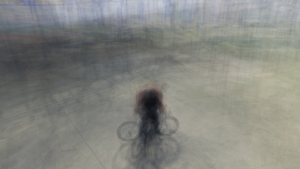
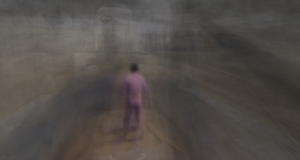
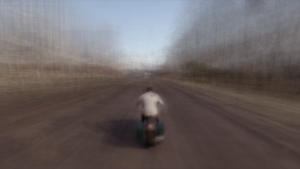
(Image credits: Images courtesy of the artist. Caspar David Friedrich, Wanderer in the Sea of Fog, 1819, oil on canvas, Kunsthalle Hamburg, Hamburg, Germany, via Wikimedia Commons.)
Dispatches from the Field: Pax East: Transcript
“I’m at PAX East because I’ve been really into video games and board games for years.”
“We’re here because we love gaming and we always want to see what’s on the forefront of the industry.”
“This is my first PAX East. It just seemed like it would be fun to come to.”
“I just love gaming. Love the people here. Love meeting new people.”
“I love cosplay. I love gaming. I work so much and it’s so great to get away and be in a community full of people that are just as crazy as you are!”
Return to the video.



